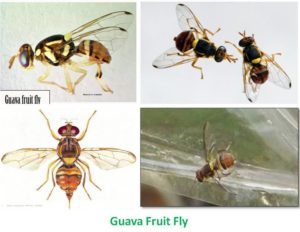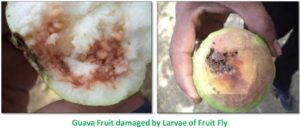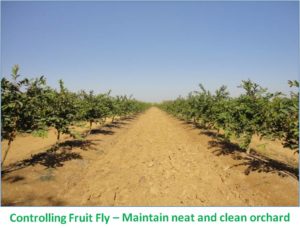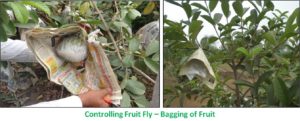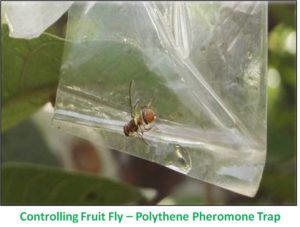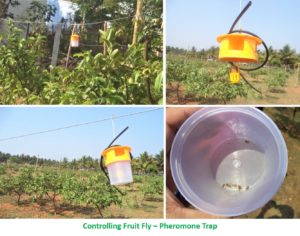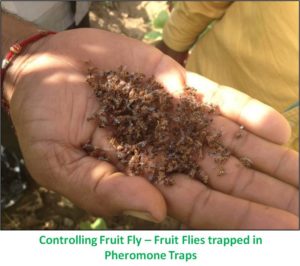< Back to Insects Management
What is Fruit Fly?
Fruit Fly is a flight insect which is most commonly found in all parts of country. Its small fly which feeds on fruit in both its adult and larval stages. Sweet fragrance of ripening Guava attracts fruit fly. Indian Guava fruit is mainly infested by Bactrocera correcta and B. dorsalis.
Fruit Fly is polyphagous in nature which means it feeds on wide variety of crops. The fruit fly can hamper the production of guava in a large numbers, particularly during rainy season, when the activity of this insect is commonly prevalent.
Life Cycle of Fruit Fly is divided in to four stages
Egg: Eggs are laid in fruit by female. These eggs get hatched within 1-2 days.
Larval: Larvae plays a key role in damaging guava fruits as it feeds on fruit pulp for its development. This stage of larvae development takes around 10-12 days.
Pupation: The pupation generally takes place in soil, for as long as 8- 10 days. This is the stage where it develops itself into an adult fly.
Adult: Adult fruit flies are released after pupation is over. Adult can live 2-3 months in external atmosphere.
How Fruit Fly damages Guava fruit?
- The female fruit fly lays its eggs in the fruit
- The development of these eggs takes place inside fruit. Where these eggs develops into larvae, which is also known as maggots
- The larvae feed on pulp of guava fruit, which severely damages the fruit by tearing or crushing and it falls off on soil
- Mostly after harvesting of popular fruit mangoes, this pest shifts over to guava with its peak population in July-August. Thereafter, population declines and larvae hibernates in winter
What are the symptoms of Fruit Fly infestation?
- Minute holes/ depressions can be seen from where the eggs have been laid in
- Fruit soften at the site of infestation
- The affected fruits rot and drop down prematurely. Ovipositional apertures lead to secondary infection by several pathogens
How to manage or control Fruit Fly?
Cleanliness of Orchard:
Cleanliness is the most effective way to decrease pest & disease infestation in an orchard. Its recommended to always keep the orchard free of weeds and plant debris.
Clearing off dropped/fallen fruits from orchard floor. This will help in checking the carryover of pest.
Bagging of Fruits:
Bagging of fruits is another effective practice to control fruit fly infestation. It not only safeguards the fruit from damages but also prevents sun burn and improves texture and quality of guava fruits
Regular soil Tillage:
Tillage is an important operation in controlling guava fruit fly. It exposes larvae to external atmosphere where they are fed by other predators. Also, direct exposure to sun causes solar heat and terminates them.
Setting up Pheromone Traps:
Fruit fly being flight insects are difficult to control with regular insecticidal sprays therefore its recommended and advantageous to choose pheromone traps. Use of methyl eugenol pheromone traps is found to be effective in controlling this pest. These pheromone traps are also helpful in early detection of these pests and controlling its population. It is recommended to setup 10 Pheromone traps in a plot size of 1 acre, where they are hanged at a height of 5 to 6 feet, well before the ripening of fruits. These pheromone traps needs to be replaced at weekly intervals
Placement of Pheromone Traps: These traps can be placed in site where fruit flies are mostly seen in the orchard. It can be hanged in tree trunks itself. The motive of this exercise is to cover major areas of the orchard.
Disclaimer:
- Above recommendations are purely based on our own understanding of subject and practices followed. It is further developed by experiences shared by our VNR Bihi Guava Growers Community.
- Our intention is not to promote any chemical formulation, brand or company products – directly or indirectly.
- Quality of chemicals or other inputs are manufacturers & sellers dependant and we are not to be held responsible for it.
- Growers need to confirm the same from the manufacturer & seller of applied inputs.
- In case of any confusion or dilemma Growers are suggested to consult technical advisory team of VNR Nursery, visit nearest KVKs (Krishi Vigyan Kendras), Central or State Government Agricultural Universities and Research Stations.

